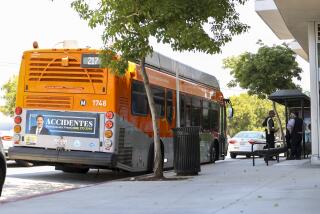Transit Commission Marks 10th Anniversary
- Share via
With one eye on the future and the other on the past, the Ventura County Transportation Commission marked its 10th anniversary Friday with a brief celebration.
“As we look back on the agency’s achievements, we must also look forward to the challenges ahead,” Chairwoman Nancy Grasmehr said. “There’s so much to be proud of, but still a lot of work to do.”
Based in Ventura, the 15-employee commission manages the growth of the county’s transportation network, and has steered a number of major highway projects to completion.
In 1991, the commission broke ground on a $33-million freeway project that linked California 118 and California 23, allowing motorists to avoid surface streets in Moorpark and Simi Valley.
After several years of planning and review, construction began on widening the notorious California 126 from Santa Paula to Fillmore in late 1997. The project was completed last fall after it was fast-tracked because of a spate of fatal accidents along a stretch of the winding, two-lane roadway known as “Blood Alley.”
The commission was also largely responsible for bringing Metrolink to Ventura County after signing an agreement with Southern California Rail in 1990 to begin studies and planning.
The commuter train began operations in 1992 with stops in Simi Valley and Moorpark, with service later expanded to Oxnard and Camarillo.
Ridership remains relatively low, and the line is still heavily subsidized. But transportation officials in Ventura and Los Angeles counties say they are committed to the route.
The agency was also responsible for starting the VISTA program--a bus service providing links to the county’s 10 cities for residents without cars and those unable to drive.
Those achievements, however, have not come without setbacks, transportation officials said.
Voters in 1990 rejected a sales tax measure that would have generated about $25 million a year for transportation projects.
“Financially, we’ve always been in a pretty tight situation,” Executive Director Ginger Gherardi said. “And that’s still the case.”
The commission’s annual budget is $12.8 million, which comes mostly from federal and state gas and highway taxes.
The next 10 years will be an even greater challenge than the first, as the county’s population and transportation needs increase, officials said.
For instance, Caltrans projects an 8% increase in traffic on the Ventura Freeway from Thousand Oaks to Los Angeles County by 2003.
Perhaps the biggest question for the commission is how the county will pay for widening the Ventura Freeway over the Santa Clara River--the principal cause of congestion on the county’s busiest roadway.
Funding disputes between Ventura and Oxnard are among the roadblocks.
But several other key projects are underway.
The Victoria Avenue and Ventura Freeway interchange redesign is nearing completion in Ventura. Nearby, the Ventura Freeway is being widened between Vineyard Avenue and Johnson Drive, except for the Santa Clara River bottleneck.
Although a solid timetable has not been set, the commission has secured funding to widen California 23 from four to six lanes between Moorpark and Thousand Oaks.
There are also plans to widen portions of California 118 from Moorpark to Somis, but Somis residents have complained the project would bring urban development to Las Posas Valley.
An analysis has also begun on how to ensure a smooth traffic flow from the Ventura Freeway in Camarillo to the planned Cal State University campus three miles away at the old state hospital.
That Lewis Road improvement would include a new freeway interchange--already funded by the state--and widening the narrow two-lane country road to the campus.
“I am convinced that under their direction, the county of Ventura will be well-served,” departing Commissioner Roma Armbrust said.
More to Read
Sign up for Essential California
The most important California stories and recommendations in your inbox every morning.
You may occasionally receive promotional content from the Los Angeles Times.













